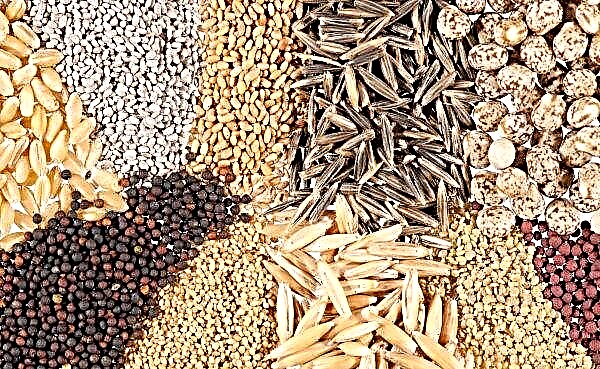Europeans got acquainted with tobacco in 1492 thanks to Columbus. It quickly began to spread over these lands and after 130 years the first bans on its use appeared. Despite this, the popularity of tobacco has grown rapidly. Along with it, the intensity of passions grew between supporters of the benefits of tobacco and supporters of its harm. It continues to this day. This article just talks about the positive and negative sides of this plant.
Chemical composition
Tobacco is an annual or perennial plant in the Solanaceae family. The main thing that this plant contains is nicotine, an alkaloid that stimulates the production of adrenaline and dopamine. Its content depends on the type of tobacco and ranges from 1–4%.
Other chemicals contained in the leaves of the plant:Did you know? In 1850, there was a noisy process in Belgium over the poisoning of the brother of the wife of Count Bokarma. The consultant was the chemist Jean Serve Stas, who determined that nicotine was the poisonous substance. He also developed a method for detecting alkaloids, which is still used today, but with some modifications.
- carbohydrates (2–20%);
- proteins (1-3%);
- organic acids (5-17%);
- essential oils (0.1–1.7%);
- sterols;
- phenolic compounds;
- glucose;
- acids (citric, nicotinic);
- solid particles (ash, ash);
- carbon monoxide.
Properties of tobacco for the body of men and women
The influence, both positive and negative, of tobacco on the body is due to the substances that make up its composition.
Benefit
The beneficial effect of tobacco is associated with the presence of nicotine in it, as well as cotinine, a product of nicotine metabolism.

- According to scientists, these substances have such an effect on the body:
- able to prevent cancer caused by carcinogens of tobacco smoke;
- suppress an acute desire to take a drug, which can help in the fight against drug addiction;
- niacin (nicotinic acid) removes certain types of drugs and poisons from cells and tissues;
- has anti-inflammatory effect;
- increases the attention and speed of information processing in people in old age;
- increase metabolism and reduce appetite, thereby fighting overweight;
- weakens the effect of alcohol;
- improves intestinal motility and stimulates the formation of a protective mucous layer, which is useful for peptic ulcers;
- inhibits tuberculous bacilli, even those that have become resistant to antibiotics;
- have a positive effect on the psyche, relieving depression, stress and nervous tension, as they stimulate the production of the hormone of happiness;
- improve coordination, increase reaction rate, endurance;
- stimulate blood circulation, vascular restoration, which helps wounds heal faster, and also solve problems associated with blood circulation;
- reduce the likelihood of facial herpes.
There is a positive effect of tobacco on pregnant women. It was unlikely that this could have been suggested, but according to some scientists, smoking women in position have a reduced risk of preeclampsia and eclampsia (seizures similar to epileptic), hypertension, and complicated toxicosis. In addition, the probability of uterine fibrosis is reduced, especially in women with menopause, as well as endometriosis.Important! Scientists have found that one smoked cigarette reduces BMI by 0.23 units. Along with this, the likelihood of overweight is reduced by 2.5%.
Harm
At the same time, tobacco is very harmful to humans, since in addition to nicotine, it contains other substances that adversely affect the body:
- carcinogens - cause all kinds of cancer;
- a number of elements from the periodic table (mercury, lead, iron, etc.), as well as naphthalene, ammonium, methanol, which settle on the lungs, clogging them;
- polonium - a radioactive element that irradiates the smoker from the inside.

- As a result of this, a smoking person develops diseases:
- respiratory system;
- cardiovascular;
- gastrointestinal tract.
In addition, if nicotine is ingested in large doses, it will turn into poison. In the modern world, there is such a thing as passive smoking - unconscious inhalation by any person of the second-hand smoke that is released by a smoker.
Many scientists argue that this type of smoking is no less harmful than normal, and here's why:
- increases the risk of cancer;
- may cause otorhinolaryngological problems;
- increases the risk of problems in the circulatory system;
- causes respiratory system diseases (asthma);
- detrimental to the fetus.
Important! The lethal dose of nicotine is 0.5–1 mg / kg of body weight.
In a separate group, the harm of passive smoking for children is allocated:
- sudden infant mortality syndrome;
- asthma;
- pulmonary infections;
- severe course of bronchitis;
- increased likelihood of tuberculosis;
- allergic reactions;
- Crohn's disease;
- developmental problems (mental and physical);
- the risk of caries, inflammation of the organs of hearing increases.
Types of tobacco
The genus of tobacco plants unites 75 species.

According to the method of use, they can be divided into:
- snuff (tobacco dust with flavorings);
- chewing (tobacco dust with various additives to give viscosity);
- nasvay (analogue of the previous type);
- sucking (peeled tobacco with salt and flavorings);
- smoking.
The latter, in turn, is divided into:
- tube;
- cigarette
- hookah;
- for self-rolls.
You can also divide tobacco into:
- natural (they are all of the above types);
- clean (usually used in the preparation of snuff and sucking species);
- samosad (most often grown in private areas for the manufacture of cigarettes or for domestic, medical needs).
Did you know? In 1560, Jean Nico de Villemen began to popularize tobacco in high society, claiming that it is a drug.
Tobacco use
It is already customary that tobacco is used for smoking. In fact, its scope is quite wide.
In pure form
In its pure form, the plant is widely applicable in agriculture. It is indispensable in crop rotation. The method of growing it, as well as the structure of the bush contribute to shading of the soil, which has a beneficial effect on crops grown after it.

The plant helps to fight with various pests (aphids, ants, thrips). To do this, it is enough to plant it on a bed between other crops or to prepare infusions for processing plants from its leaves.
In the form of a cigarette
In the manufacture of cigarettes from tobacco, bundles are formed that are wrapped in special paper. For the filling, chopped or chopped tobacco leaf of any grade and type is usually used. The shape and size of the product can be any.
In composition, they are divided into:
- oriental blend;
- American Blend;
- with menthol;
- kretek and others
Important! Separate smoking tobacco. They start as cigarettes, cigarettes, and cigarettes.
Depending on the filling and the proportion of nicotine there are:
- bidi (thin, short cigarettes with Indian tobacco and herbs);
- cretec (contain Javanese tobacco and chopped cloves);
- picadura (Spanish cigarettes with black tobacco);
- corporal (a mixture of black French varieties);
- american blend (varieties Virginia, Breli, Oriental with aromatic additives);
- jomen blend (50% of the filling of the previous species, 50% of the eastern varieties);
- English blend (from several varieties of the Virginia variety, sometimes with the addition of flavorings);
- european bag (something intermediate between the two previous options with a minimum content of aromatic additives);
- oriental cigarettes (stuffed with skeletal and aromatic tobacco);
- cigarettes (filled with cut tobacco leaf from which they make sleeves wrapped in tissue paper).
In medicine
Even our ancestors used tobacco to treat various ailments, as a sedative, expectorant, diuretic, emetic. Modern medicine has found another application for him.

Alzheimer's Disease Prevention
American scientists have found that cotinine can improve memory and protect neurons from destruction. It is believed that this action of the substance will prevent the progression of Alzheimer's. Successful experiments have been carried out so far on mice, and statistics have encouraged their implementation, saying that smokers suffer less from this ailment.
Relief of schizophrenia
Nicotine activates two types of receptors in the brain. Some have a high affinity for him, while others have a low affinity. The number of the latter is usually reduced in the brain cells of those with schizophrenia. As a result of their stimulation, the functionality of the cerebral cortex increases, and the manifestations of cognitive dysfunctions caused by the disease also decrease.
Parkinson's disease prevention
The occurrence of Parkinson's disease is associated with the destruction and death of neurons that produce dopamine, especially in the black substance, which is responsible for motility, muscle tone and a number of body functions. Its lack leads to a malfunction in the basal nuclei (accumulation of gray matter in the thalamus), which is responsible for motor and autonomic function.
Nicotine, on the other hand, stimulates the production of dopamine, thereby maintaining it at the proper level in the body, and therefore, delaying the manifestations of the disease and facilitating its course.
From the foregoing, we can conclude that the usefulness of the plant lies in the nicotine contained in it, as well as the product of its metabolism - cotinine. All other substances harm the body. Therefore, if we talk about smoking, then it does more harm than good.












